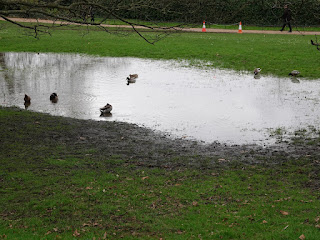The young Grey Herons on the island have come down from the nest for the first time. One of them was exploring the exciting new territory of the shore. They can now fly well enough to get back up for their parents to feed them.
The other wasn't showing and must have been back in the bushes. There was a bird in the upper nest, but the view from the other side of the lake showed it was one of the parents, here at top left above the empty nest.
The heron at the west end of the island was sitting down in the nest out of sight, but appeared for a few seconds when it got up and turned round before settling down again. This may be a sign that it was sitting on eggs, but it's too early to be sure.
The one at the other end of the island is certainly sitting, but it doesn't make much of a photograph.
A Dunnock at the northwest corner of the bridge sang a couple of phrases, and then annoyingly refused to sing any more.
The familiar male Chaffinch turned up at the back of the Albert Memorial. He had brought his mate with him. She too is now flying out to catch pine nuts in midair.
One of the pair of Robins by the Henry Moore sculpture glanced back over its shoulder.
Two pairs of Long-Tailed Tits were bouncing around in the trees at the back of the Lido.
The Grey Wagtail was working its way along the edge.
A Blackbird came out on the roots of one of the enormous old plane trees in the Dell.
There were a couple of Jackdaws in the Rose Garden.
The Peregrines were calling to each other on the barracks tower.
One of the teenage Mute Swans, now thrown out by its ferocious parents, dared to come on to the Long Water and cruise past them on the gravel strip. For the time being they were too busy preening to chase it away.
A pair of swans displayed to each other near the east end of the Lido. This is where a nest site is available for the first pair that cares to take it.
The last surviving Egyptian gosling had wandered off along the edge of the Serpentine, unnoticed by its careless mother and in deadly danger from Herring Gulls. I shooed it back to her.
Yesterday's rain has produced a new flood on the hill behind the Lido, which some Mallards were enjoying.
Also at the Lido, the dandelions are beginning to flower.
The first tulips are coming out in the Rose Garden. I prefer honest dandelions to these gaudy things.















There is something so oddly plastic-like, almost disturbing, about cultivated flowers.
ReplyDeleteGreat news about the Heron teen being strong enough already to explore a brave new world. Live long and prosper, young Heron!
Tinúviel
Yes, I really don't like huge lurid glossy overbred flowers, and much prefer little wild things that gardeners would class as weeds. I suppose I have a weed mentality myself.
ReplyDeleteThere are little tulips , usually referred to as 'species', that are apparently like the original wild ones (from the steppes of central Europe , I think ?) . They have a very different vibe from their blousy cousins. But I too like a dandelion.
DeleteEven awful things like gladioli have sweet little wild ancestors. Breeders do terrible things to flowers and dogs.
DeleteGood news on the Heron front. When I visited Lonsdale Rd Reservoir (Leg of Mutton) last week I couldn't see any Herons on the nests there while doing my WeBS survey.
ReplyDeleteI do love seeing the Dandelions in profusion & so important for a wide range of polinators. Also love tulips. This one isn't too dissimilar to some of the wild species. For several years I lead tours to Kazakhstan where on the spring visits the wild species of tulips were one of the highlights. We would see about 15 of the 30 or so species that occur there.
Have you read about the Dutch tulip mania of 1630-37, when one bulb of the most expensive variety, Semper Augustus, cost as much as a house? It makes you look at the things in a very different way.
DeleteYes some of those tulips went for such crazy money. I think Anna Pavord covered it in her tulip book.
ReplyDeleteI read Mike Dash's book Tulipomania, most interesting. There's also a good account in George Mackay's Extraordinary Popular Delusions and the Madness of Crowds, readable online at
Deletehttps://www.gutenberg.org/files/24518/24518-h/24518-h.htm